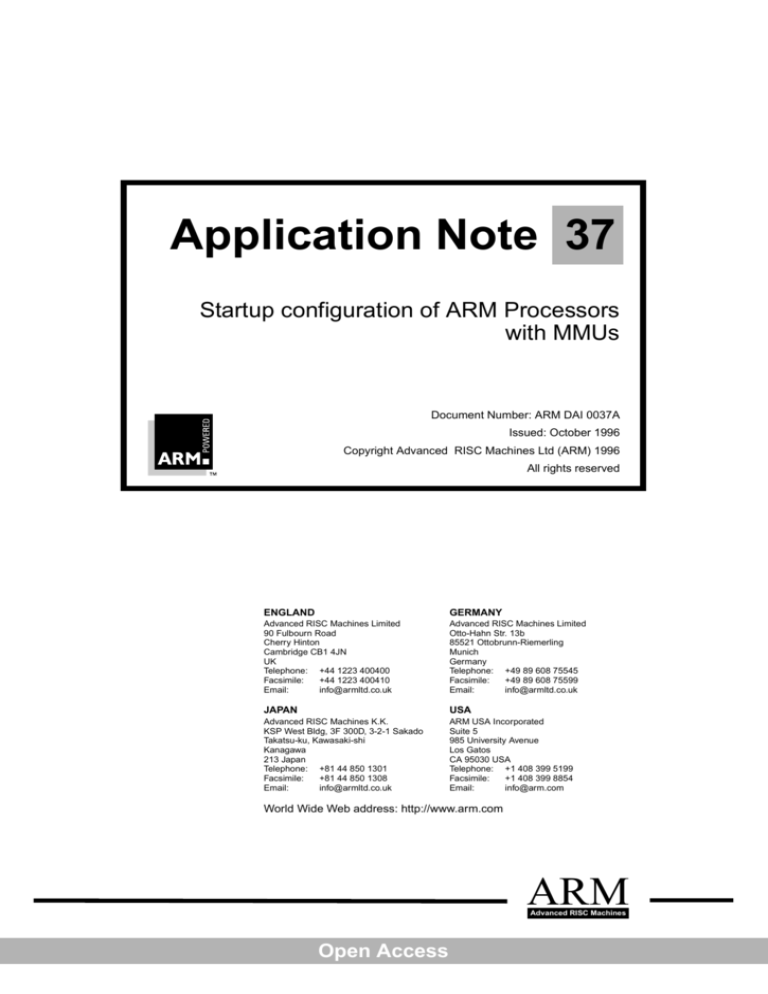
Application Note 37
Startup configuration of ARM Processors
with MMUs
Document Number: ARM DAI 0037A
Issued: October 1996
Copyright Advanced RISC Machines Ltd (ARM) 1996
All rights reserved
ENGLAND
GERMANY
Advanced RISC Machines Limited
90 Fulbourn Road
Cherry Hinton
Cambridge CB1 4JN
UK
Telephone: +44 1223 400400
Facsimile:
+44 1223 400410
Email:
info@armltd.co.uk
Advanced RISC Machines Limited
Otto-Hahn Str. 13b
85521 Ottobrunn-Riemerling
Munich
Germany
Telephone: +49 89 608 75545
Facsimile:
+49 89 608 75599
Email:
info@armltd.co.uk
JAPAN
USA
Advanced RISC Machines K.K.
KSP West Bldg, 3F 300D, 3-2-1 Sakado
Takatsu-ku, Kawasaki-shi
Kanagawa
213 Japan
Telephone: +81 44 850 1301
Facsimile:
+81 44 850 1308
Email:
info@armltd.co.uk
ARM USA Incorporated
Suite 5
985 University Avenue
Los Gatos
CA 95030 USA
Telephone: +1 408 399 5199
Facsimile:
+1 408 399 8854
Email:
info@arm.com
World Wide Web address: http://www.arm.com
ARM
Advanced RISC Machines
Open Access
Proprietary Notice
ARM, the ARM Powered logo, and EmbeddedICE are trademarks of Advanced RISC Machines Ltd.
Windows 95 is a registered trademark of Microsoft Corporation.
Windows NT is a trademark of Microsoft Corporation.
Neither the whole nor any part of the information contained in, or the product described in, this document may be adapted or
reproduced in any material form except with the prior written permission of the copyright holder.
The product described in this document is subject to continuous developments and improvements. All particulars of the product and
its use contained in this document are given by ARM in good faith. However, all warranties implied or expressed, including but not
limited to implied warranties or merchantability, or fitness for purpose, are excluded.
This document is intended only to assist the reader in the use of the product. ARM Ltd shall not be liable for any loss or damage
arising from the use of any information in this document, or any error or omission in such information, or any incorrect use of the
product.
Key
Document Number
This document has a number which identifies it uniquely. The number is displayed on the front page and at the foot of each
subsequent page.
ARM XXX 0000 X - 00
(On review drafts only) Two-digit draft number
Release code in the range A-Z
Unique four-digit number
Document type
Document Status
The document’s status is displayed in a banner at the bottom of each page. This describes the document’s confidentiality and its
information status.
Confidentiality status is one of:
ARM Confidential
Named Partner Confidential
Partner Confidential
Open Access
Distributable to ARM staff and NDA signatories only
Distributable to the above and to the staff of named partner companies only
Distributable within ARM and to staff of all partner companies
No restriction on distribution
Information status is one of:
Advance
Preliminary
Final
Information on a potential product
Current information on a product under development
Complete information on a developed product
Change Log
Issue
Date
By
Change
A
October 1996
JS
First release
Application Note 37
ii
ARM DAI 0037A
Open Access
Table of Contents
1
2
3
Introduction
26-bit and 32-bit configurations
Big or little endian configuration
Application Note 37
4
5
8
1
ARM DAI 0037A
Open Access
2
Application Note 37
ARM DAI 0037A
Open Access - Preliminary Draft
Named Partner Confidential
Introduction
1
Introduction
The early ARM processors (pre-ARM6) implemented a 26-bit address range and
were little endian only. ARM6 and later ARM cores expanded the address range
to 32-bits, and provided both little- and big-endian support.
This application note examines how the choice of address range and endianism
is controlled on ARM processors containing an ARM Memory Management Unit
(MMU). This includes all revisions of all ARM 6- and ARM 7-based cached
processors:
• ARM600
• ARM610
• ARM700
• ARM710
• ARM710a
• ARM710ac
• ARM7100
• ARM7500
• ARM7500FE.
The selection of endianism is also relevant to:
• ARM810
• StrongARM.
Application Note 37
3
ARM DAI 0037A
Open Access
26-bit and 32-bit configurations
2
26-bit and 32-bit configurations
The first ARM designs implemented a 26-bit address space, a combined program
counter and status register, and limited processor modes for dealing with
exceptions. With the ARM6 and ARM7, these changed to a full 32-bit address
space, separate program counter and status registers, and additional processor
modes.
To allow the running of operating systems written for earlier 26-bit ARM
processors, ARM6 and ARM7 offer a 26-bit configuration to allow backwards
compatibility. The recommended operation for new designs is 32-bit configuration.
Furthermore, when in a 32-bit configuration, a 26-bit mode may be entered by
software for partial emulation of earlier systems.
The configuration controls whether a 26 or 32-bit mode is entered upon an
exception, and also whether 32-bit modes are available (they are not available in
26-bit configuration). In addition, if the core is in a 26-bit mode, but in 32-bit
configuration, writing to the vector table (addresses 0x0 -> 0x1c) will cause a data
abort (a vector exception). The abort allows a 32-bit OS to intercept 26-bit
applications writing to the vector, to allow veneer code to make a transition from
the 32-bit mode entry to the 26-bit mode handler, and back again when the handler
returns.
Further details of the 26-bit and 32-bit configurations can be found in ARM
Application Note 11: Differences between the ARM6 Series and Earlier ARM
Processors.
2.1
Configuration control
The ARM6 and ARM7 cores provide the signals PROG32 and DATA32 to control
whether the core will start up in 26 or 32-bit configuration. These signals are not
pinned out on ARM6 or ARM7 based processors with MMUs, but are instead
controlled by coprocessor 15 register 1, bits 4 and 5 respectively.
At reset on ARM processors with MMUs, the PROG32 and DATA32 bits in CP15
register 1 are set low and place the processor in 26-bit configuration. Because of
this configuration setting, after reset the processor enters the reset handler
executing in 26-bit supervisor mode.
Setting the PROG32 and DATA32 bits high will change to 32-bit configuration.
However, it will not change the current processor mode, so the processor will
continue operating in the current 26-bit mode until an explicit mode change is
carried out. In addition, if an exception is generated before an explicit mode
change, it will cause a 32-bit mode to be entered but will typically restore the 26bit mode that was current at the time the exception was generated upon its return.
2.2
Changing configuration and mode
To change from a 26-bit configuration to a 32-bit configuration, and change from
a 26-bit mode to a 32-bit mode, you must:
1 Use an MCR instruction to set bit 4 (PROG32) and bit 5 (DATA32) of CP15
register 1.
2 Use an MSR instruction to change the CPSR control byte to its standard
value on reset in 32-bit configuration, which is:
4
Application Note 37
ARM DAI 0037A
Open Access - Preliminary Draft
Named Partner Confidential
26-bit and 32-bit configurations
a) I and F bits set to disable interrupts
b) Bit 5 clear
c) Mode bits equal to 10011, to select SVC32 mode.
Thus the necessary startup code to change into 32-bit configuration and 32-bit
MOV r14, #0x70
; Set PROG32 and DATA32 (and late abort)
MCR p15, 0, r14, c1, c0
MOV r14, #0xD3
; I,F bits set; not Thumb; SVC32 mode.
MSR CPSR_c, r14
; Writes only bits 7:0 of the CPSR
The following points should be noted:
2.3
•
The processor must be in a privileged mode to execute this code.
•
The machine cannot access a memory location above 64 MBytes before
this code is executed.
•
The machine cannot execute code beyond 64 MBytes before this code is
executed.
•
Upon reset, the processor will set PROG32 and DATA32 to low,
regardless of their previous state. Therefore, this code must always be run
by your reset handler.
•
This code should be run as soon as possible after reset - probably as the
first thing done in the reset handler. This is to avoid the risk of executing
instructions whose effects differ (sometimes subtly) between 26-bit and
32-bit modes, or of entering an exception vector in a 26-bit mode. (In
particular, do not enable interrupts and do not execute a SWI, an
undefined instruction or an instruction that may cause a prefetch or data
abort before running this code.)
•
On ARM6-based cached processors, this code also selects the late abort
model. This is done to achieve a startup state consistent with that of
ARM7-based cached processors, on which this is the only abort model. If
your code is for ARM6-based processors only, and you want to use the
early abort model, replace the initial MOV r14,#0x70 instruction with MOV
r14,#0x30.
•
This code should not be used on processors without an MMU because the
MCR instruction will cause an undefined instruction exception to be taken
on such processors.
Configuration on future processors
ARM810 and StrongARM are different to earlier ARMs because the 26-bit
configuration is not implemented on these processors. Both are permanently in
32-bit configuration, though the 26-bit modes are implemented. However, on reset,
the processor will be 32-bit mode (SVC32). Therefore on these processors, no
part of the code described in section 2.2 Changing configuration and mode on
page 5 is needed.
Attempting to cause a configuration change on ARM810 or StrongARM by writing
to bits 4 or 5 of CP15 reg 1 is simply ignored. These bits are effectively hardwired
to 1, setting 32-bit code and 32-bit data configuration.
Application Note 37
5
ARM DAI 0037A
Open Access
26-bit and 32-bit configurations
Therefore, if the code described above is run on these processors it will no do
anything. Code which is intended to run both on the affected processors, and on
ARM810 or StrongARM, can run the code described in section 2.2 Changing
configuration and mode on page 5 regardless which processor is being used.
2.4
26-bit modes on future ARM cores
You should note that the 26-bit modes also have a limited lifespan. They have
already been dropped completely in the ARM7TDMI core, and they are not likely
to be implemented on any ARM cores subsequent to the ARM8 and StrongARM.
The use of these modes is therefore not recommended.
Application Note 37
6
ARM DAI 0037A
Open Access
Big or little endian configuration
3
Big or little endian configuration
The ARM can treat words in memory as being stored in either little endian or big
endian format. In little endian format, the least significant byte of a word is stored
in bits 0-7 of an addressed word. In big endian format, the least significant byte of
a word is stored in bits 24-31 of an addressed word.
3.1
Endianism control
The ARM core provides signal BIGEND to control whether the core will start up in
big or little endian configuration. This signal is not pinned out on ARM processors
with MMUs, but is instead controlled by coprocessor 15 register 1, bit 7.
At reset on ARM processors with MMUs the BIGEND bit in CP15 register 1 is set
low and so places the processor in little endian configuration.
3.2
Configuring endianism
If a little endian system is being used, no further action is required because this is
the default configuration. However, if big endian configuration is required it is
necessary to use an MCR instruction to set bit 7 (BIGEND) of CP15 register 1.
Therefore, the startup code to give a 32-bit address space, described in section
2.1 Configuration control on page 5, could be modified to cause a change into
big endian configuration as follows:
MOV r14, #0xF0
; Set BIGEND, PROG32 and DATA32
; (and late abort)
MCR p15, 0, r14, c1, c0
MOV r14, #0xD3
; I,F bits set; not Thumb; SVC32 mode.
MS
; Writes only bits 7:0 of the CPSR
CPSR_c, r1
This could be simplified on processors that do not implement 26-bit configurations,
as only BIGEND then needs setting:
MOV r14, #0x80
; Set BIGEND
MCR p15, 0, r14, c1, c0
Note
Again, the code to change the endianism of the processor should be executed as
soon as possible after reset, and certainly before any subword-sized memory
accesses are made.
The endianism configuration has no effect on how ARM instructions are fetched
from memory, and you should assemble or compile all of the application code
(including the startup code) for the endianism that your system will run in once the
appropriate selection is made.
Application Note 37
7
ARM DAI 0037A
Open Access
Big or little endian configuration
Application Note 37
8
ARM DAI 0037A
Open Access







